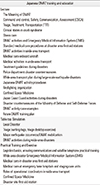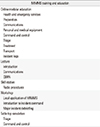Abstract
Education and training of disaster medicine are the most important part of disaster management. There are so many training and education curriculum all over the world. However education courses based upon core competencies of disaster medicine are lacking. There is still a need to define the specific knowledge, skills, and attitudes that must be mastered by specialized professionals. Standardized core competencies for acute care medical personnel such as emergency department nurses, emergency physicians, and out-of-hospital emergency medical services personnel are needed to ensure that effective emergency medical response can be provided efficiently during all types of disasters. Therefore education and training curriculum of other countries were reviewed in this article.
Figures and Tables
References
1. Noji EK. The public health consequences of disasters. 1st ed. New York: Oxford University Press;1997. p. 120–124.
2. Ciottone GR. Disaster medicine. 1st ed. Philadelphia, PA: Mosby;2006. p. 4–5.
3. Guha-Sapir D, Hoyois P, Below R. Annual Disaster Statistical Review 2013: the numbers and trends [Internet]. Brussels: Center for Research on the Epidemiology of Disaster;c2014. cited 2015 April 29. Available from: http://cred.be/sites/default/files/ADSR_2013.pdf/.
4. Subbarao I, Lyznicki JM, Hsu EB, Gebbie KM, Markenson D, Barzansky B, et al. A consensus-based educational framework and competency set for the discipline of disaster medicine and public health preparedness. Disaster Med Public Health Prep. 2008; 2:57–68.

5. Daily E, Padjen P, Birnbaum M. A review of competencies developed for disaster healthcare providers: limitations of current processes and applicability. Prehosp Disaster Med. 2010; 25:387–395.

6. Huntington MK, Gavagan TF. Disaster medicine training in family medicine: a review of the evidence. Fam Med. 2011; 43:13–20.
7. Collander B, Green B, Millo Y, Shamloo C, Donnellan J, DeAtley C. Development of an "all-hazards" hospital disaster preparedness training course utilizing multi-modality teaching. Prehosp Disaster Med. 2008; 23:63–67. discussion 8-9

8. Smith J, Levy MJ, Hsu EB, Lee Levy J. Disaster curricula in medical education: pilot survey. Prehosp Disaster Med. 2012; 27:492–494.

9. Schultz CH, Koenig KL, Whiteside M, Murray R. Development of national standardized all-hazard disaster core competencies for acute care physicians, nurses, and EMS professionals. Ann Emerg Med. 2012; 59:196–208.e1.

10. Coule PL, Schwartz RB. The national disaster life support programs: a model for competency-based standardized and locally relevant training. J Public Health Manag Pract. 2009; 15:S25–S30.
11. National Disaster Life Support Foundation. Couses: CDLS, BDLS, ADLS [Internet]. Augusta (GA): NDLSF;c2003. cited 2015 April 13. Available from: http://www.ndlsf.org/index.php/courses/www.ndlsf.org/index.php/courses/.
12. Fuse A, Yokota H. An analysis of Japan Disaster Medical Assistance Team (J-DMAT) deployments in comparison with those of J-DMAT's counterpart in the United States (US-DMAT). J Nippon Med Sch. 2010; 77:318–324.

13. Anan H, Akasaka O, Kondo H, Nakayama S, Morino K, Homma M, et al. Experience from the Great East Japan Earthquake response as the basis for revising the Japanese Disaster Medical Assistance Team (DMAT) training program. Disaster Med Public Health Prep. 2014; 8:477–484.

14. Sammut J, Cato D, Homer T. Major Incident Medical Management and Support (MIMMS): a practical, multiple casualty, disaster-site training course for all Australian health care personnel. Emerg Med (Fremantle). 2001; 13:174–180.

15. Disaster Management [Internet]. Darwin (AUS): National Critical Care and Trauma Response Centre;c2005. cited 2015 April 14. Available from: www.nationaltraumacentre.nt.gov.au/what-we-do/disaster-management/.
16. Aitken P, Leggat PA, Robertson AG, Harley H, Speare R, Leclercq MG. Education and training of Australian disaster medical assistance team members: results of a national survey. Prehosp Disaster Med. 2011; 26:41–48.





 PDF
PDF ePub
ePub Citation
Citation Print
Print






 XML Download
XML Download